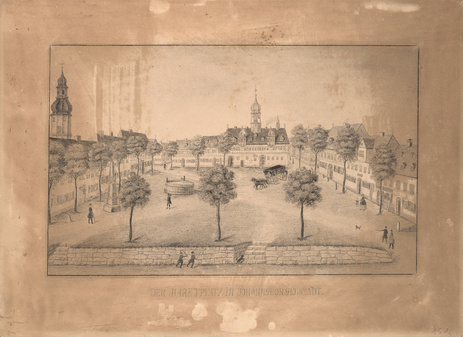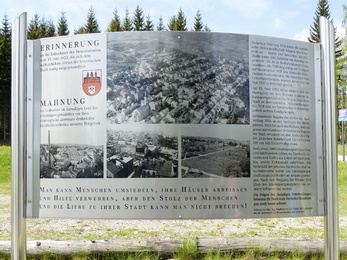Johanngeorgenstadt als verschwindende Stadt. Eine historische und geographische Mikrologie des Verlusts
 Drawing of the former market square in Johanngeorgenstadt dating from approx. 1840. 260x420 mm
Drawing of the former market square in Johanngeorgenstadt dating from approx. 1840. 260x420 mm(translated project title)
“One can resettle people, tear down their houses and refuse them help, but people’s pride in and love of their town cannot be broken!” those are the words on a memorial plaque in Johanngeorgenstadt. It was erected in 2013 to commemorate the resettlement of the town’s population and the protests against it in the year 1953. Between 1950 and 1970 in Saxony and Thuringia several towns simply disappeared off the face of the maps. They had to give way to uranium mining by “Wismut”, a Soviet-German joint stock corporation. Alongside some places in Thuringia, for example in Oberschlema in the Erz Mountains, between 1952 and 1957 some 1,700 inhabitants were resettled because of mining damage. Particularly hard hit was the small town of Johanngeorgenstadt in Saxony. Founded close to the border with Bohemia by religious refugees shortly after the Thirty Years’ War, after the Second World War the town was for a short time a centre of uranium mining. Its population rose from initially about 7,000 in 1946 to over 40,000 by the mid-1950s. In the years 1951 to 1957, 4,000 inhabitants of the old town centre were resettled to the newly-built “Neustadt” – the official reason given was damage by the mining. The town thus lost its historical centre and not least with the discontinuation of mining operations by Wismut in 1958 entered a long phase of demographic decline. In the year 1976, about 10,000 people still lived there, in the year 2000 the figure was 6,300, and today it is merely 3,897.
 Plaque commemorating the participants in the protest against the 1953 resettlement, with views of the town.
Plaque commemorating the participants in the protest against the 1953 resettlement, with views of the town.There were primarily economic reasons for the decline: Alongside the downturn in mining, in the wake of German unification other sectors such as the textile and furniture industries found themselves in crisis. One hurdle to tapping into new business sectors, such as tourism for example, is the face of the town itself, which was destroyed during the mining years. The fact that the old town was torn down is a major burden on the town. The research project by Dr Manuel Schramm and Prof. Simon Runkel sets out to investigate the creative way the inhabitants have tackled this loss. How did the locals cope with the loss of material places associated with memories? Did the loss of the old town prompt an exodus to the West or to other regions in East Germany? And what impact did and does this have on local biographies and practices? Are there strategies of resilience in approaching incisive experiences of loss and what factors favour their adaptation?
In two sub-projects, the researchers analyse what impact the demolition of the old town continues to have on the town’s cultural and social identity: In the historiographical section the focus is on the transformation in the local perceptual, knowledge and mnemonic culture as well as in how the authorities handled resettlement and protest. In the socio-geographical section, the current shared atmosphere of loss is traced on the basis of biographies and lifeworld experiences and the locals’ related practises explored together with them.
The overall result is a micrology of loss that measures the interaction of historical, geographical, cultural and social factors in a confined space and contributes to a better understanding of the phenomenon of “Lost Cities”. The project’s findings will be presented at two workshops and also published as a monograph. Furthermore, the plain is to discuss new prospects for Johanngeorgenstadt locally in the context of a future workshop and in this way lend voice to the local population’s concerns.
Project leadership
PD Dr. Manuel Schramm
Prof. Dr. Simon Runkel
Institution
Technische Universität Chemnitz
Friedrich-Schiller-Universität Jena
Support
The Gerda Henkel Foundation supports the project by granting a research and a doctoral scholarship as well as covering personnel and travel costs.
The project was documented in spring 2023.

